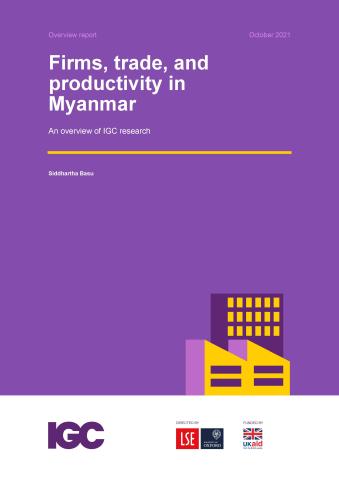-
Basu Overview report October 2021
PDF document • 385.31 KB
In view of a substantial empirical literature establishing that much of the difference in economic output across countries can be explained by differences in total factor productivity (TFP), we organise our discussion under the following subheadings, each of which refers to an area where reforms have the potential to bring about TFP improvements at the country level:
- Productivity within firms
- Creation and accumulation of higher quality factors of production
- Improving resource allocation through better-functioning markets
The IGC’s research on productivity within firms in Myanmar has primarily concentrated on two areas that the existing empirical evidence suggests are important for within-firm productivity and for which there are significant quick and low-cost wins to be had – the health of relations between employers and workers and the quality of management practices. The main findings and recommendations are as follows:
- With regards to employer-worker relations, IGC research into Myanmar’s garment sector points towards a vital role for worker-leaders inside factories in resolving disputes between workers and employers before they reach a stage where outside mediation is required. This underscores the importance of ensuring workers’ freedom of association. A review of the existing barriers in this regard would be a valuable exercise.
- On the quality of management practices, IGC research in Thilawa Special Economic Zone (SEZ) suggests that providing English language training in multinational companies to facilitate communication between foreign senior and domestic middle managers could lead to significant within-firm productivity gains by enhancing the ability of the latter to learn better management skills from the former. This raises the question of whether there is a case for the government to subsidise English language training in Thilawa.
With regards to the creation and accumulation of higher quality factors of production, the IGC’s work has spanned diverse sectors and in each case yielded a separate set of recommendations. At a high level, these comprise the following:
- In the Myanmar garment sector, there is scope for the government to boost the incentives of workers to upgrade their skill levels by participating in training opportunities both inside and outside of the factory, whether by subsidising training programmes themselves or by encouraging firms to link their bonus structures in part to further training.
- The IGC’s research into language barriers in Thilawa SEZ suggests that domestic managers in zone-based MNCs who pick up new skills from their foreign senior managers are likely to eventually leave their jobs and contribute to skill levels in the wider domestic economy, which strengthens the case for the government to subsidise English language training to facilitate this process.
- The IGC’s initial work on the issue of inadequate agricultural financing in Myanmar suggests that agricultural value chain finance – an approach that would leverage the superior information possessed by agricultural value chain actors with the financial resources of private banks – may be particularly promising among potential solutions, but additional research is required in this area.
- IGC research in Myanmar’s rice sector identifies inadequate electricity as a major barrier to achieving improvements in productivity and quality at the mill level. The overview report on IGC Myanmar’s work in the energy and electricity sector goes into much greater detail on the issue of national electrification and potential policies to expand it.
- Greater ability on the part of traders and farmers to accurately measure the quality of paddy could benefit productivity in the rice sector overall. Affordable moisture sensors and table-top mills are already available in the country, and the IGC’s initial research suggests that promoting usage of these among farmers and traders could help in achieving such an outcome.
With respect to improving resource allocation through better-functioning markets, the IGC’s research in Myanmar speaks to a wider literature that highlights the role of market distortions in developing countries that serve to punish – in effect, tax – more productive firms (which is equivalent to subsidising less productive ones). These are damaging for aggregate TFP because they lead to an inefficient allocation of society’s resources. Specific findings and recommendations from this work are as follows:
- An IGC study looking at the removal in 2013 of the import license requirement in certain sectors suggests that political connections can and do shield firms in Myanmar from competition and, in doing so, constrain the extent to which productivity gains can be achieved from trade liberalisation. Eliminating the import license policy altogether – except for in the case of sensitive products – would alleviate this constraint.
- The outsized role of state-owned banks in providing subsidised financing to the agricultural sector has resulted in chronic underprovision of much-needed credit and other financial services in the sector by crowding out commercial sources of formal finance. This situation is made worse by interest rate caps that prevent the adoption of risk-based pricing among commercial banks that would otherwise be in a position to serve the sector.
- According to an IGC pilot study, Myanmar consumers often purchase foreign-produced goods that are not cheaper or necessarily even better quality than domestically produced versions of the same. This suggests that the government should look into some form of quality certification that would help to dispel biased priors among Myanmar consumers of the quality of foreign-produced goods relative to their locally produced counterparts.
- There is evidence that Myanmar’s bean export sector is hampered by a costly search process for overseas buyers who wish to identify a suitable Myanmar exporter with whom to place orders. Interviews with buyers suggest that a transparent feedback mechanism where foreign buyers can leave publicly visible ratings of exporters from whom they have sourced would help to address this issue.



